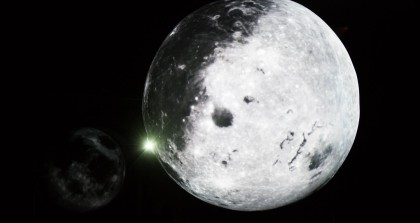Kelly Nunes – Moon Room Composition
For those who have been to Never Apart, we’re sure many would agree that one of the focal points is our ‘Moon Room’ permanent installation, created by Kelly Nunes, Adam Sajkowski, and Oliver Simpson.
From the day we opened our doors, the Moon Room has provided many a highlight and photo opportunity for passersby. The 40-minute audio accompaniment, composed by Nunes, is the cherry on top of an overall stellar immersive experience. For the first time, we’re publishing the Moon Room Composition to be heard outside of our centre, and in the process, caught up with Nunes about what went into the piece.
How and where was the soundtrack made ?
My good friend and sometimes collaborator Kevin Moon has a Yamaha CS60 which we divined could produce some lunar tones. I went to his crib and he just started riffing on the thing. I’d be like “yeah yeah, word, more of that, ok, word, not so much, ok ok, yes, yeah, dope!…” and he was quite patient and co-operative given the circumstances, but he’s used to me being a perennial dumb ass who needs his help for stuff like this. We recorded him trying different things for about two hours. I then took the audio home and started culling sections that were too far-out, or too cliché. I wanted it to sound like outer space, without going into sci-fi soundtrack territory.The sections that remained got roughly arranged, and then stitched together by some string and reed patches from Kontakt. It began to take on a faint thematic identity, which I then anchored around a recurring piano, and sustained kick motif. From there I just kept reducing it like the nice tomato sauce your Nonna makes.
Making music is very much like making sauce, it’s true ! Now how did you approach this composition differently than say some of the other pieces you’ve made ?
Most pieces I’ve worked on ran 5 mins or less. I hoped people would be sitting in there for extended periods of time, more than, say, 15 minutes. The room was designed for viewers to decompress; that takes time, so I decided early on that the piece would have to be loooong. The main challenge was gonna be pacing and arranging what ended up becoming a 40 minute piece. I didn’t want someone sitting in there for 15 minutes to hear the same piece loop at any point. That might unintentionally, subconsciously, inform them that the piece had “ended”, or run it’s course. The music shouldn’t cue anyone to leave. Hearing the piece end/loop may have produced that result.
For anyone who has been in the Moon Room, I think many would agree that it is quite easy to be “taken” by the size of the moon and the sensory experience associated with the visuals of the room itself. How did you ensure not to “overload” the composition in a way that kept it as a backseat to the installation itself, while still keeping it as a highly integral feature of the overall experience ?
I’ve scored music for films. I approached the Moon in a similar way: play a supporting role, no guitar solos. Asses the physical characteristics: perceived weight, mass, levity, rotation velocity, opacity, etc., and the “mood” of the Moon: mysterious, ancient, secretive, omniscient, sacred, enigmatic, impenetrable, etc. How one chooses to express these qualifiers through sound is of course somewhat subjective, and principally intuitive. Someone else may have composed a waltz, and that could have worked on some level, too, but the aim was to keep people in their seats, contemplating the mysterious enchantment we all have with this glowing celestial body. The soundtrack accompanying the contemplation should be perceived secondarily, while remaining an essential facet of the whole experience.
There are a variety of different “moods” during the 40 minutes— piano stabs, dubby/low frequency bits, some bleepy vintage modular sounding stuff… What made you want to go that route in covering so much sonic ground as opposed to a more “cohesive” piece ?
I was concerned that, what with the piece being so lengthy, viewers would require new stimuli every now and then. The variety of instrumentation hopefully served this purpose. The piano and choir would provide some needed respite from the jarring contra-bassoon sections, and anxious high frequency modular-synth bleeps and squeals. I hoped to keep the viewer seated for a while by sequencing slightly anxious sections followed by tranquil sections. Too much piano and they might fall asleep. Too much contra-bassoon and they might flee, post haste. Hopefully, as Depeche Mode enjoined, I got the balance right.
Any particular compositional inspirations that the soundtrack draws upon ?
Depeche Mode “Get the Balance Right” !! hehe…but i digress. Kevin Moon was an inspiration! I also like Shoji Yamashiro female choral arrangements. I thought a bit about Akira while putting in the choirs. Aside from that I like the long reverb tails in Eno and Aphex Twin ambient pieces, how they’re used to create space and grain. Also, I’d played a lot with contra-bassoon in the floaty glide cam sequences of a film I’d just scored for Nika Khanjani‘s “Free World Pens”, and I loved the sub harmonics rumbling through the theater when it screened; so when I knew we were getting a sub in the Moon Room I went the low reed route again. Lou Reed was not an inspiration for this piece.* But he is an inspiration.






View Comments
No Comments (Hide)